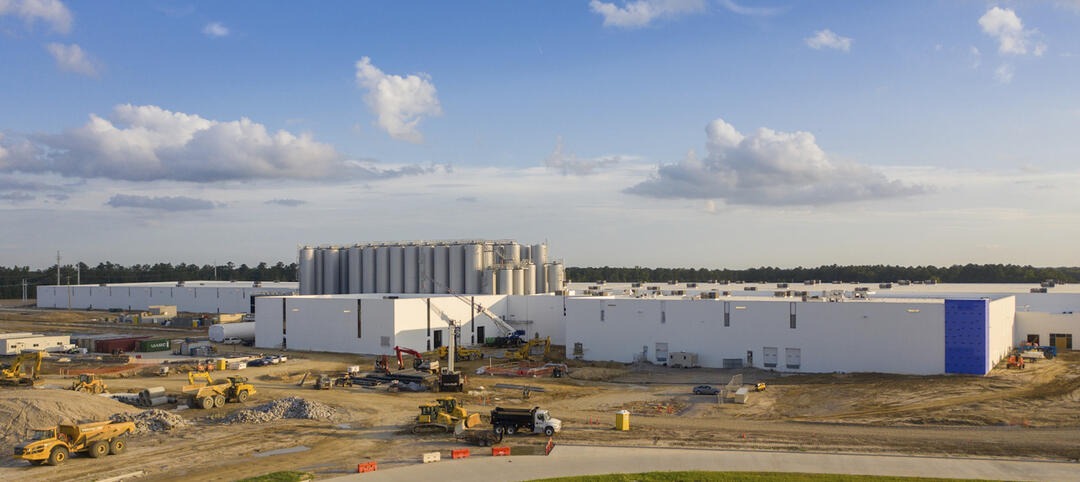Hard to believe, but we’re only six months away from the day—January 1, 2014, to be precise—when the Affordable Care Act will usher in a radical transformation of the American healthcare system. Healthcare operators are scrambling to decipher what the new law will mean to their bottom lines and capital facility budgets.
For advice on how AEC firms can succeed under Obamacare, we turned to Patrick E. Duke, Senior Vice President at KLMK Group (www.klmkgroup.com), which advises healthcare operators on the planning and construction of capital facilities.
Duke, a BD+C “40 Under 40” honoree (Class of 2010), says firms must home in on three trends: 1) the shift by healthcare providers toward “population-based management”; 2) the push toward a fast-paced “retail environment” in healthcare; and 3) heightened interest in energy and operational cost savings among healthcare operators.
1. POPULATION-BASED MODEL HELPS SPREAD THE RISK
Today’s version of “fee-for-service,” whereby healthcare operators are reimbursed more on volume than on patient outcome, is on the way out, says Duke. It is being replaced by a system in which healthcare operators will be given a set amount of money to manage the care of a defined population of patients.
TOP HEALTHCARE ARCHITECTURE FIRMS
2012 Healthcare Revenue ($)1 HDR Architecture $185,763,0002 HKS $134,000,0003 Cannon Design $109,000,0004 Perkins+Will $100,962,2555 Stantec $98,471,4576 NBBJ $96,169,0007 HOK $84,300,0008 SmithGroupJJR $66,700,0009 Perkins Eastman $63,800,00010 RTKL Associates $60,746,000
TOP HEALTHCARE ENGINEERING FIRMS
2012 Healthcare Revenue ($)1 AECOM Technology Corp. $180,210,0002 Jacobs Engineering Group $77,100,0003 URS Corp. $43,327,3324 Smith Seckman Reid $40,105,6005 KPFF Consulting Engineers $30,000,0006 Affiliated Engineers $28,217,0007 TTG $24,719,9058 Parsons Brinckerhoff $22,700,0009 Dewberry $21,226,70210 Allen & Shariff $20,300,000
TOP HEALTHCARE CONSTRUCTION FIRMS
2012 Healthcare Revenue ($)1 Turner Corporation, The $1,856,850,0002 McCarthy Holdings $1,750,000,0003 Clark Group $1,055,387,8704 Skanska USA $833,093,7005 Brasfield & Gorrie $780,723,2476 JE Dunn Construction $759,053,6317 DPR Construction $749,013,6118 PCL Construction Enterprises $729,454,5149 Whiting-Turner Contracting Co., The $551,510,96710 Robins & Morton $545,100,000
Giants 300 coverage of Healthcare brought to you by DuPont www.fluidapplied.tyvek.com.
To be profitable under such a regimen, says Duke, healthcare operators will have to control costs by, ironically, keeping people out of the hospital. They will do so through various means: limiting the use of expensive emergency room visits, treating patients in lower-cost outpatient facilities, keeping people healthy through wellness programs, and cutting down on readmissions.
“The common response among providers thus far has been to cast as wide a net as possible to spread the risk over a broader population, just like life insurance,” says Duke. Some healthcare systems are growing their patient bases by buying up or merging with other providers. A more common practice is to build specialty facilities to provide more profitable services outside the hospital setting.
For example, the University of Maryland Medical System will open a 68,000-sf cancer center at its Upper Chesapeake Health affiliate in Bel Air, Md., in September. The new center will save local residents the 30-mile trip to UMMS’s Baltimore campus, while solidifying its position in the suburban market northeast of the city.
“Healthcare providers are looking at the services they can offer that are more specialized, with better outcomes in a lower-cost setting,” says Duke. AEC firms must be prepared to respond to this shift in direction.
2. ‘RETAIL HEALTHCARE’ PUTS EMPHASIS ON SPEED TO MARKET
As healthcare moves into more of a retail mode, getting specialty outpatient and primary-care outreach units to market as quickly as possible will be top-of-mind for hospital execs. Duke believes that will make them more open to modular construction. “If modular can get the facilities up faster to capture a growing market and get the cash registers ringing sooner, they’ll go with it,” he says.
Repurposing existing spaces is another route that healthcare systems are using to widen their patient bases quickly. In the Atlanta area, for example, Kaiser Permanente continues to explore repurposing vacant Blockbuster stores into neighborhood clinics, which then feeds patients into the Kaiser system. Vanderbilt University Medical Center has done the same at 100 Oaks Mall in Nashville, with great success.
“Healthcare operators want designers and contractors who can evaluate a building and come back quickly with solutions,” says Duke. Firms that can offer systems solutions for new facilities—designing standard units, bundling them, and rolling them out fast—will also be in demand, he says.
3. SAVING EVERY NICKEL ON ENERGY AND OPERATIONS
Healthcare providers are finally getting serious about saving on energy and operational costs. “Before Obamacare, they focused on supply chain and wouldn’t get serious about energy or facility operations because they didn’t need to,” says Duke. “As systems consolidate, they have the scale explore options like energy monitoring and retrocommissing, to identify sustainable cost-saving solutions.”
Another route to controlling costs is to develop new facilities under Performance Guaranteed Facilities arrangements. Under a PGF, the hospital contracts with a service provider to finance, plan, design, build, and maintain facilities over a 20- to 30-year period, at a fixed total cost.
“The hospital owns the building and the land, but the service provider takes the risk of developing the facility and maintaining it, including replacing equipment on an ongoing basis,” says Duke. This sheds a lot of risk for the hospital. If, for example, the OR goes down due to a maintenance error, the PGF provider takes the hit.
Duke says that, in Canada, value-for-money studies showed that life cycle cost savings averaged 15-20% on a net present value basis through the use of PGFs to build and operate new healthcare facilities versus traditional project delivery options.
The witching hour for Obamacare is fast approaching. Will your firm be ready to compete in the new American healthcare landscape?
Read BD+C's full Giants 300 Report
Related Stories
| Sep 8, 2022
The Twin Cities’ LGBTQ health clinic moves into a new and improved facility
For more than 50 years, Family Tree Clinic has provided reproductive and sexual health services to underserved populations—from part of an old schoolhouse, until recently.
| Sep 8, 2022
U.S. construction costs expected to rise 14% year over year by close of 2022
Coldwell Banker Richard Ellis (CBRE) is forecasting a 14.1% year-on-year increase in U.S. construction costs by the close of 2022.
Giants 400 | Sep 7, 2022
Top 110 Industrial Sector Contractors + CM Firms for 2022
Clayco, Arco Construction, Ryan Companies, and STO Building Group top the ranking of the nation's largest industrial facility sector contractors and construction management (CM) firms for 2022, as reported in Building Design+Construction's 2022 Giants 400 Report.
| Sep 7, 2022
K-8 school will help students learn by conducting expeditions in their own communities
In August, SHP, an architecture, design, and engineering firm, broke ground on the new Peck Expeditionary Learning School in Greensboro, N.C. Guilford County Schools, one of the country’s 50 largest school districts, tapped SHP based on its track record of educational design.
| Sep 6, 2022
Herbert V. Kohler, Jr. (1939-2022) An incomparable spirit
Dynamic leader and Kohler Co. Executive Chairman Herbert Vollrath Kohler, Jr. passed away on September 3, 2022, in Kohler, Wisconsin.
| Sep 6, 2022
Demand for flexible workspace reaches all-time high
Demand for flexible workspace including coworking options has never been higher, according to a survey from Yardi Kube, a space management software provider that is part of Yardi Systems.
| Sep 2, 2022
Converting office buildings to apartments is cheaper, greener than building new
Converting office buildings to apartments is cheaper and greener than tearing down old office properties and building new residential buildings.
| Sep 2, 2022
New UMass Medical School building enables expanded medical class sizes, research labs
A new nine-story, 350,000 sf biomedical research and education facility under construction at the University of Massachusetts Chan Medical School in Worcester, Mass., will accommodate larger class sizes and extensive lab space.
| Sep 1, 2022
ABC: Nonresidential Construction Spending Increases by a Modest 0.8% in July
National nonresidential construction spending increased 0.8% in July, according to an Associated Builders and Contractors analysis of data published today by the U.S. Census Bureau.
| Aug 31, 2022
A mixed-use development in Salt Lake City provides 126 micro units with mountain views
In Salt Lake City, a new 130,000-square-foot development called Mya and The Shop SLC, designed by EskewDumezRipple, combines housing with coworking space, retail, and amenities, as well as a landscaped exterior for both residents and the public.


















